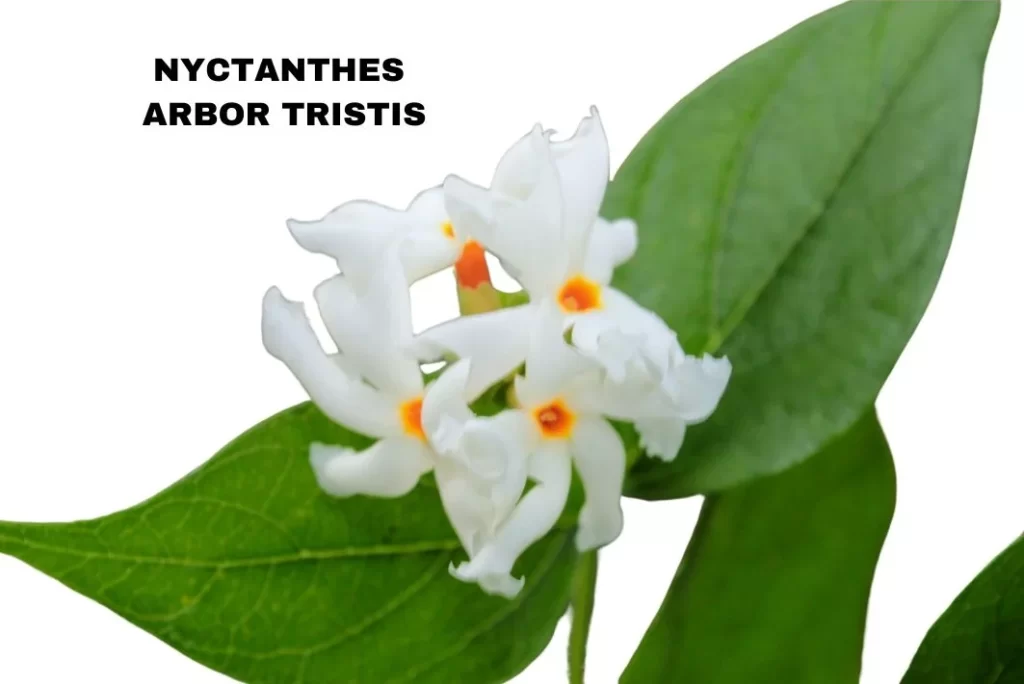Nyctanthes Arbor Tristis, commonly known as the Sad Tree or Paghala-malli, is a homeopathic remedy primarily used for conditions such as bilious and obstinate remittent fever, sciatica, rheumatism, and constipation in children.
It is characterized by symptoms like restlessness, dull headaches, burning sensations in the stomach relieved by cold applications, and specific modalities during fever stages.

SOURCE INFORMATION
Scientific Classification
- Kingdom: Plantae
- Family: Oleaceae
Origin and Historical Facts
- Origin: Nyctanthes Arbor Tristis is native to Southeast Asia, particularly India, where it is culturally significant and used in traditional medicine.
- Historical Facts: In traditional practices, various parts of the Nyctanthes Arbor Tristis tree, including its leaves and flowers, have been used for their medicinal properties, addressing conditions ranging from fevers to rheumatism.
DRUG PATHOGENESIS
- Nyctanthes Arbor Tristis acts primarily on conditions associated with fevers, including bilious and obstinate remittent fever.
- It also addresses rheumatic complaints, sciatica, and constipation in children.
- The remedy exhibits symptoms such as restlessness, headaches, burning sensations in the stomach, and specific modalities during fever stages, including thirst before and during chills, relief from vomiting at the end of chills, and unremarkable sweating.
KEY CHARACTERISTICS
HEAD
- Anxious and restless: Restlessness accompanies various symptoms.
- Dull headache: A persistent, subdued headache.
- Coated tongue: Tongue shows a visible coating, indicating digestive disturbances.
STOMACH
- Burning sensation: Feeling of heat and discomfort in the stomach.
- Relief from cold applications: Symptoms improve when cold is applied.
- Thirst: Increased desire for fluids.
- Relief from vomiting: Vomiting provides relief during the closing stages of chills.
ABDOMEN
- Tenderness of liver: Sensitivity and discomfort in the liver area.
- Profuse, bilious stool: Abundant stools with bile content, accompanied by nausea.
- Constipation: Difficulty in passing stools, particularly observed in children.
FEVER
- Thirst: Increased desire for fluids before and during chills and heat stages.
- Better from vomiting: Relief observed at the conclusion of the chill phase.
- Sweat not marked: Perspiration is not prominently observed during fever episodes.
MODALITIES
Better: Certain factors or interventions alleviate symptoms.
DOSE
- Tincture: Administered in drop doses.
Frequently Asked Questions (FAQs)
What conditions can Nyctanthes Arbor Tristis treat?
- It is used for bilious and obstinate remittent fever, sciatica, rheumatism, and constipation in children.
How does Nyctanthes Arbor Tristis affect fever symptoms?
- It addresses symptoms like thirst before and during chills and heat, with relief observed from vomiting at the end of the chill phase.
What are the key symptoms indicating the need for this remedy?
- Key symptoms include restlessness, dull headaches, burning stomach sensations relieved by cold, and specific modalities during fever episodes.
Meaning of Difficult Words
- Bilious: Related to bile or characterized by excess bile secretion.
- Remittent fever: Fever that fluctuates but does not disappear.
- Sciatica: Pain affecting the back, hip, and outer side of the leg.
- Rheumatism: Pain and inflammation affecting joints, muscles, and connective tissues.
- Constipation: Difficulty in passing stools.
- Tincture: A herbal extract dissolved in alcohol.
